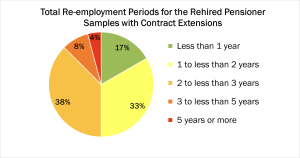
Why This Audit Matters
Workforce planning and management, including succession planning, are critical in ensuring that the Toronto Transit Commission’s (TTC) non-union workforce meets its operational requirements to support providing public transit services to the City of Toronto, particularly as the number of employees at or nearing retirement eligibility is increasing.
Background
This audit assessed whether the TTC has established and implemented workforce planning systems, policies, procedures, and processes to ensure its non-union workforce meets operational requirements.
The TTC’s non-union employee positions include a variety of administrative, supervisory, and professional roles that support the delivery of the TTC’s services.
By The Numbers
- 4,000 (25% of total) non-union employees with a salary and benefit expense of $603 million (28% of total) in 2024
- Average 100 non-union retirements per year from 2019 to 2023
- 1 in 5 non-union employees are eligible for retirement by the end of 2027
- 43% of rehired pensioners sampled received a pay premium, ranging from 5% to 24% above the position’s approved pay rate for a total incremental cost of $508,000 for the past five years.
- 60% of the Auditor General’s non-union survey respondents who indicated they filed a complaint, were not at all satisfied with how the matter was handled.
What we found
A. Enhanced Workforce Planning, Monitoring, and Succession Planning is Needed
- Although the TTC tracks some human resources related-metrics, such as turnover, on an ad hoc basis at a corporate-wide level, the TTC does not have a formalized:
- process to define, measure, or monitor human resources related key performance indicators (KPIs), including formalized targets and benchmarks; or
- corporate-wide succession planning program in place.
B. Policy for Rehiring Pensioners Needs Strengthening
- The TTC’s retirement policies do not include a requirement for employees to notify management and/or the People and Culture Group of their intent to retire. The TTC also does not have a mandated or suggested retirement notification period.
- A lack of succession planning and the TTC’s retirement policies have contributed to the TTC rehiring pensioners to fill vacancies.
- Although it is not uncommon for organizations to rehire pensioners on a temporary, short-term basis, we found issues with the practices at the TTC in rehiring pensioners that should be addressed:
-
- As allowed by TTC policy and the TTC Pension Plan Bylaws and Regulations, rehired pensioners were paid both employment and pension income simultaneously.
- Pensioners are sometimes paid at a premium and appointed into new roles without an open job competition.
- Our survey of non-union employees showed employee concerns about the TTC’s practice of rehiring pensioners, and the negative impact on overall employee engagement and retention.
- Pensioners are sometimes re-employed after retirement for long periods of time, with half employed for two years or more (see graph below for our audit sample results).

C. Monitoring of Employee Feedback and Engagement Needs Strengthening
- The TTC has not been regularly monitoring employee engagement and satisfaction. The Auditor General’s non-union employee survey found average scores have not improved since TTC’s last engagement survey in 2016.
- Results of exit surveys from departing employees and common themes/trends are not analyzed to address areas of concern to help address turnover.
D. Process for Managing, Tracking, and Addressing Employee Concerns and Complaints Needs Improvement
- There is overlap and unclear roles and responsibilities among the TTC’s three investigative units. Complaints were transferred between them, without formal tracking, which can sometimes delay the timing of the investigation and resolution.
How Recommendations Will Benefit The City
Implementing the seven recommendations in the report will help improve the TTC’s non-union workforce planning and management processes, contributing to a positive impact on employee engagement and retention of its existing workforce. While this audit focused on the TTC’s non-union workforce, many of the recommendations can also be applied in managing human resources for the rest of its workforce.